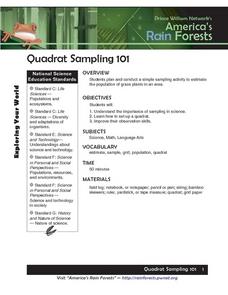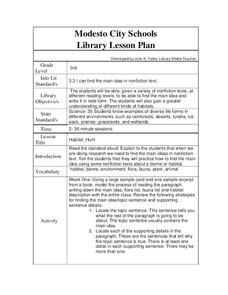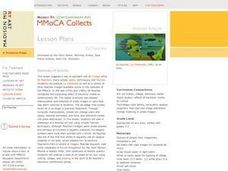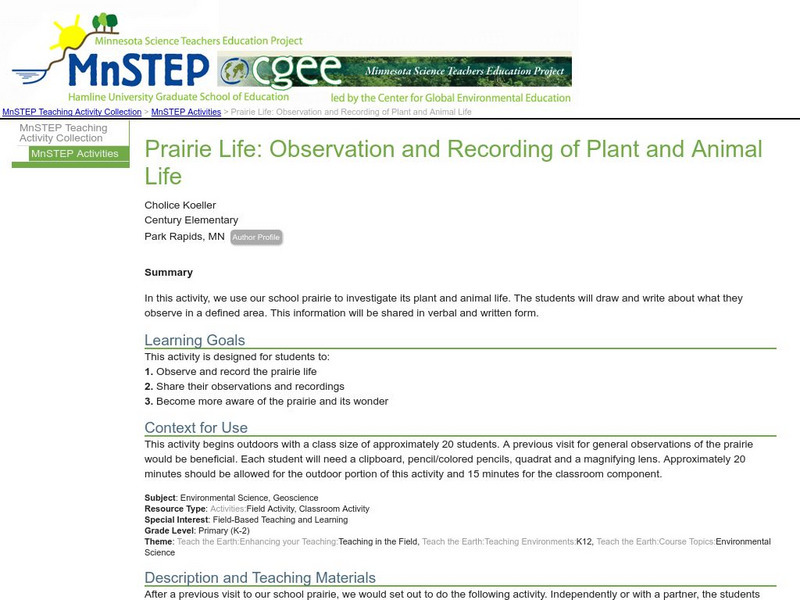Curated OER
What Big Teeth You Have:
Students make their own tooth impressions of a sharp and a flat tooth and compare the differences. They make impression of fossil teeth from dinosaurs comparing the sharp and flat teeth and learning about their uses.
Curated OER
Push or Pull
Students study the forces, push and pull. They conduct demonstrations of pushing and pulling. They examine the Nebraska state quarter for an example of pulling.
Curated OER
Diversity - Grade 8
Eighth graders consider the diversity of the First Nations cultures in Canada. In this cultural diversity lesson, 8th graders research the cultural groups of the First Nations as well as their contributions to Canadian society. Students...
Curated OER
Quadrat Sampling 101
Students explore the population of grass plants in a given area. They plan and conduct a sampling activity to estimate the population of dandelions or the number of grass blades on the school grounds.
Curated OER
Self-Test Quiz: Wild Children Part III: Comparing and Contrasting
In this comparing and contrasting instructional activity, students are given pairs of sentences they must combine using the conjunction but.
Curated OER
The Battle of Honey Springs: The Civil War Comes to the Indian Territory (68)
Learn how the Civil War created fierce conflicts among American Indian nations who had been moved across the Mississippi River.
Curated OER
Which One Matters?
Students study the balance necessary to maintain ecosystems and how changing that balance can impact the ecosystem. They identify and discuss the need for balance in any ecosystem and discuss how greenhouse gases impact ecosystems.
Curated OER
Biological Diversity and Conservation
In this conservation biology instructional activity, students will complete 9 short answer questions on the different strategies of conservation biology, including the Endangered Species Act and establishing protected areas for animals.
Curated OER
Worksheet #79 - American Pioneer
In this American pioneer quiz activity, students advance their understanding of the early American pioneer days by answering ten fill in the blank questions.
Curated OER
Habitat Hunt
Third graders read several nonfiction texts and practice finding the main idea for the text as well as learn about various habitats. In this main idea lesson, 3rd graders read several nonfiction texts and make habitat cards. Students...
Curated OER
Is There A Fungus Among Us?
Sixth graders classify fungus into two different groups. In this fungus lesson plan, 6th graders collect as many pieces of fungus as possible. Students then classify these pieces of fungus as saprophytic or parasitic.
Curated OER
Iowa: Reading Comprehension
For this Iowa reading comprehension worksheet, students read a 2-page selection regarding the state and then respond to 10 true or false questions.
Curated OER
Bringing Illinois into the Curriculum
Students of all ages are introduced to the geography of Illinois. Depending on the grade level, they participate in different activities which allow them to discover Illinois in the past and present. They examine the animals and...
Curated OER
Exploring Habitats
Students analyze the difference between the human habitat and the different habitats of animals in the six lessons of this unit. The students' imaginations and literature are used to explore important aspects of the living environments...
Curated OER
Buffalo Gone: Appreciating Natural Resources
Students develop numercy skills by studying the number of bison before and after the arrival of European settlers in Canada. They examine the affect of the reduction in the number of bison on Native families.
Curated OER
Ed Paschke
Students examine and discuss the artistic style and techniques of the artist Ed Paschke. They analyze various works of art by Ed Paschke, then choose an icon from art history and alter a photocopy of it using scissors and collage materials.
Curated OER
Depending On Each Other. Communities And Ecosystems
Seventh graders investigate how the ecosystems of the world has influence upon the immediate and nonimmediate environments. The interelationships of food webs is discussed. The class researches one type of ecosystem for a class project...
Curated OER
From Bolls To Bolts
Students investigate the concept of cotton manufacturing. The skills of setting statements in chronological order is developed. They are shown pictures of products and place them in order. The lesson includes background information for...
Curated OER
Recognizing Lifestyle Changes
Students discuss the changes they are going through in their lives. Using literature, they relate the stories to their own lives and discover how to properly deal with them. They also make a list of how the scenery, transportation and...
Other
Camp Silos: Exploring the Prairie
An excellent site for studying the Iowa prairie. Offers wonderful facts and interactive activities for students to do individually or as a group. Identifies national standards and lesson plans for the teaching of prairie life. Provides...
Science Education Resource Center at Carleton College
Serc: Prairie Life: Observation and Recording of Plant and Animal Life
Students will learn about prairie life as they investigate the plants and animals that live there. They will then share their observations with their classmates.
Library of Congress
Loc: American Memory: Prairie Settlement, 1862 1912
Read letters from homesteaders in Nebraska and view photographs of prairie life in Nebraska. Visitors can browse by topic, date, or keyword.
NPR: National Public Radio
Npr: Prairie Diaries
This site from NPR is an excellent example of personal narratives from the heartland. Read and listen to excerpts from Kansans about a day in their life. What were they doing, what were they thinking, what was going on in their lives.
Smithsonian Institution
National Museum of American History: Our Story: Life in a Sod House
Imagine moving into a house made out of sod that you and your family had to build in the middle of a prairie! Find great information and activities that will help you understand how it felt to live on the prairie.























